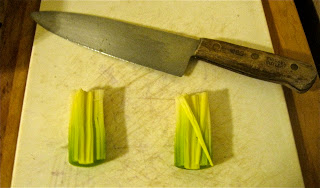I hate tofu. I realize that this doesn't make me special, because a lot of people hate tofu. It's not the taste (as it has none), it's the texture. I feel the same way about shirataki noodles - it's not just the smell, it's the slimy texture that I'd rather do without. But I used to happily incorporate other soy products into my diet, using unsweetened soy milk, soy flour, soy cereal and edamame. Then I found out about the truth about soy; it's a common allergin and it's negative impact on the human body can create all kinds of problems.
I was introduced to the excellent website of Maria Emmerich: mariahealth.blogspot .com, who has a great post on "soy's most glaring problems". Before reading this post:
http://mariahealth.blogspot.com/2011/03/salad-toppers-and-facts-on-mccormick.html#comments
I thought I was perfectly safe with organic, non - GMO soy, but I had no idea of the problems it can cause. To name of few:
*Soy contains natural toxins known as "anti-nutrients", that interfere with the enzymes needed to digest protein.
*Soy contains phytates, which prevent the absorption of minerals like calcium, magnesium, iron and zinc.
*Soy is packed with isoflavones, which are a type of phytoestrogen (a plant compound resembling human estrogen). Because they mimic estrogen, they can block the hormone which may disrupt endocrine function, can cause infertility and may promote breast cancer in women.
So there are good reasons for eliminating soy and fortunately, there are also other ways to incorporate protein into your diet if you don't or can't eat meat or soy.
I call myself an "accidental vegetarian" because I didn't begin doing low carb without eating meat. When I first started doing low carb, I not only ate meat, but regularly consumed food products loaded with artificial sweeteners and additives. But after a relatively short period of time, I lost my craving for animal flesh. I'm still not sure why, but I was also making the gradual process of adapting whole foods into my diet. Most recently, I've gone gluten free and have eliminated soy from my diet. But another important aspect of my new found vegetarianism, is the fact that over the last two years, I've been learning about the food industry and how it's unsavory practices put our health in danger and our economy and our ecology in peril. Most of the animals butchered for beef, pork and poultry products are raised in nightmarish conditions, their living quarters squeezed into the smallest possible space (to maximize profits), fed genetically modified corn (not their natural diet) and are given growth hormones (to maximize profits) and antibiotics (to keep them from getting sick from their terrible living conditions). I don't wan't to eat food that comes from those kind of conditions. And I don't want to give my money to corporations where such vile business practices are considered standard operating procedures.
If you live in the right area, you can find meat that comes from local farms, from free range animals who live and eat in natural, humane conditions and don't get pumped full of growth hormones and antibiotics. They are, however, prohibitively expensive for most people, especially in this day and age. So how
do I get enough protein in my diet? Protein powder! I don't think I would have made it through the first days of induction without it.
While smoothies are great anytime you need a quick boost of protein, they are especially great for breakfast - they can be prepared quickly and with the right ingredients, can be very filling. However, it can be something of a challenge to make them taste good. I recommend using unsweetened almond milk instead of mixing protein powder with plain water. Another option is to mix 8 oz of water with a 1/4 C of coconut milk; it gives you a burst of energy, and is a great way to start your morning. A note about coconut milk - it does not keep well in the refrigerator so I separate out 1/4 C portions in airtight containers and freeze them.
What kind of protein powder should you get? You have several options, but let's start with whey protein isolate. There are
loads of whey protein powders on the market, from companies that make all sorts of outrageous claims as to why they are the best. Never mind that they are filled artificial additives, chemicals and who knows what else. So you want to look at quality, based on what your requirements are and how much you can afford. My requirements are as follows: it has to be 100 % natural whey protein isolate ( as apposed to whey protein concentrate ), it has to be sweetened with stevia, have no artificial additives or growth hormones. My reason for insisting on the isolate rather than the concentrate, is that is has more protein with less fat and less lactose per serving than concentrate. It's more expensive, due to it's higher quality, but I think it's worth it. To this end, I tried out everything I could find and ended up with SDC Nutrition's About Time Whey Protein Isolate, which I get in both vanilla and chocolate.

It's lactose and gluten free and has zero carbs and zero fat. And it does taste good and at $1.05, it's the least expensive of the high quality whey powders. I do have to order it online, but I may be able to get my grocery/health food store to order it fo me specially - some stores do and it's worth checking out to save time and money. There are also a number of whey protein powders sweetened with stevia available online and in many stores, that aren't 100 % natural, that don't have 100 % whey protein isolate, and aren't made from whey that is produced by cows that are hormone free. But there are some that don't seem too bad. They probably taste OK and aren't prohibitively expensive. Only you can decide what's best for you - for both your health and your wallet.
Here are some ideas and variations to get you started:
Chocolate Whey Smoothie
Ingredients:
1 scoop chocolate whey protein powder
1 C unsweetened vanilla almond (you can use hemp milk instead, if you wish)
A couple ice cubes (optional)
Preparation:
*Put ingredients in a blender and mix.
Makes one serving and has 141 cal, 2 net carb, 2.5 g fat, 0 g fiber and 25 g protein (using almond milk).
Variation:
1 scoop chocolate whey protein powder
1/4 C coconut milk
8 oz water
a couple of ice cubes, optional
This has 206 cal, 3.25 net carbs, 10.5 g fat, 0 fiber and 25.75 g protein.
Berry Whey Smoothie
You can use any kind of berries for this. Fresh fruit has less carbs but you can keep frozen berries in the freezer year round.
1 scoop vanilla whey protein powder
1 C unsweetened vanilla almond milk
36 g frozen strawberries (or blueberries, raspberries or blackberries)
This has 161 cal, 4.25 net carbs, 2.5 g fat, .5 g fiber and 25 g protein.
Raw Smoothies
There are some disadvantages to raw food protein powders; they have less protein per serving and don't taste as good as whey protein powder. But they have some advantages as well. Whey protein has no dietary fiber - 30 g of hemp protein has 9 g of fiber. If you are eliminating soy milk from your diet ( I previously consumed 1 1/2 C per day, which comes out to 6 g fiber) this will more than compensate. Per serving, they have the 10 essential amino acids, the omega 3 and 6 fatty acids and are an excellent source of magnesium and iron.
It can be something of a challenge to get them to be palatable: they are unsweetened, so you will need to add stevia or another natural low carb sweetener. And you can add fruit, cocoa powder and spices to improve the taste. I've played around with different variations and have come up with a few recipes:
There are a few raw food powders that I like. There's Garden of Life Raw Protein:
It's made from a variety of sprouted grains and has 80 cal, 0 net carbs, 1 g fat, 3 g fiber and 18 g protein. It's around $1.21 per serving.
Then there are a couple of hemp protein powders. I can find this one at Berkeley Bowl, my supermarket/health food store:
Tempt has 130 cal, 1 net carbs, 4 g fat, 9 g fiber and 13 g protein and is organic raw hemp protein powder.
And then there's my favorite:
It's basically the same as Tempt but it's produced by a company called Navitas Naturals. You can find them online at:
http://www.navitasnaturals.com/. They not only strive to make the best quality products with the least amount of processing, they are committed to environmentally and socially responsible business practices. Which is important to me. I order it through Amazon and by buying in bulk I can save money. It comes out to about $1.14 per serving.
Strawberry Hemp Smoothie
3 T hemp protein powder
36 g (about a 1/4 C) frozen strawberries
1 C unsweetened vanilla almond milk
stevia, to taste
It has 180 cal, 5.25 net carbs, 5.5 g fat , 6.5 g fiber and 17 g protein.
Chocolate Hemp Smoothie
1 C unsweetened almond milk
1 T unsweetened cocoa powder
3 T hemp protein powder
stevia, to taste
This has 172 cal, 4.4 net carbs, 6.7 g fat, 6 g fiber and 18 g protein.
And then I got the bright idea of mixing the two powders together. The result was not too bad - not as great as the whey by itself, but an improvement on the hemp by itself:
Chocolate Hemp/Whey Smoothie
15 g (2 T) chocolate whey protein powder
15 g (2 T) hemp protein powder
1 C unsweetened Vanilla almond milk
Has 155.5 cal, 1.5 net carbs, 5 g fat, 5.5 g fiber and 21.5 g protein.
Strawberry Hemp/Whey Protein Smoothie
15 g (2 T) vanilla whey protein powder
15 g (2 T) hemp protein powder
1 C unsweetened vanilla almond milk
36 g frozen strawberries
Has 175.5 cal, 4.75 net carbs, 4.5 g fat, 5 g fiber and 21.5 g protein.
A note about preparing smoothies: If you're just trying to mix protein powder with liquid, go ahead and use the "Magic Bullet" (or it's equivalent). But if you're adding ice cubes and frozen fruit, I'd recommend using a real blender. I've heard too many horror stories about these machines breaking down because they don't have that capacity. A decent blender may cost more, but it's worth it.






































